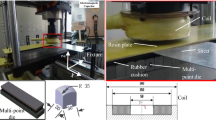Abstract
In this article, we report a new method to test the formability of low conductive metal sheet under electromagnetic forming using a single planar spiral coil. Proposed novel design of test articles can produce the biaxial tensile strain state, uniaxial tensile strain state, and plane strain state, respectively. The three strain states created by the novel specimen designs were then verified by simulations. Finally, the forming limits of Ti-6Al-4V sheet metal in three different stain states during electromagnetic forming were determined by corresponding experiments using the novel specimen designs. The results indicate that the new method is reasonable and reliable. Formability of Ti-6Al-4V titanium alloy experienced significant improvement when compared with that in quasi-static condition. The extent of improvement was greatest in the plane strain state, reaching 73.65 %. The proposed specimen designs can also be used to test the formability of sheet metal under quasi-static conditionse.
Similar content being viewed by others
References
Wang J, Goel A, Yang F, Gau J-T (2009) Blank optimization for sheet metal forming using multi-step finite element simulations. Int J Adv Manuf Technol 40(7–8):709–720. doi:10.1007/s00170-008-1383-y
Chan LC, Fu MW, Li N, Lu J (2010) FEA-aided design of multi-stage drawing process and tooling for production of a miniature sheet metal component. Int J Adv Manuf Technol 46(9–12):993–1000. doi:10.1007/s00170-009-2163-z
Daehn GS, Vohnout VJ, DuBois L (1999) Improved formability with electromagnetic forming: fundamentals and a practical example. Minerals, Metals and Materials Society/AIME, 184 Thorn Hill Road, Warrendale, PA 15086–7528, USA
Seth M, Vohnout VJ, Daehn GS (2005) Formability of steel sheet in high velocity impact. J Mater Process Technol 168(3):390–400. doi:10.1016/j.jmatprotec.2004.08.032
Hecker SS (1974) Cup test for assessing stretchability. Met Eng Q 14(4):30–36
Nakazima K, Kikuma T, Hasuka K (1963) Study on the formability of steel sheets. Yawata technical report 264:141–154
Golovashchenko SF (2007) Material formability and coil design in electromagnetic forming. J Mater Eng Perform 16(3):314–320
Li C, Liu D, Yu H, Ji Z (2009) Research on formability of 5052 aluminum alloy sheet in a quasi-static-dynamic tensile process. Int J Mach Tools Manuf 49(2):117–124. doi:10.1016/j.ijmachtools.2008.10.006
Dariani BM, Liaghat GH, Gerdooei M (2009) Experimental investigation of sheet metal formability under various strain rates. Proc Inst Mech Eng B J Eng Manuf 223(6):703–712. doi:10.1243/09544054jem1430
Chen Y-J, Lee R-S, Gau J-T (2012) Formability evaluation by novel specimen designs in sheet metal forming with two-step strain paths. Proc Inst Mech Eng B J Eng Manuf. doi:10.1177/0954405412468559
Lee R, Cheng T, Luo F (2010) A novel formability test method for electro-magnetic forming of aluminum sheet. Steel Res Int 81(9):1042–1047
Rohatgi A, Soulami A, Stephens EV, Davies RW, Smith MT (2014) An investigation of enhanced formability in AA5182-O Al during high-rate free-forming at room-temperature: quantification of deformation history. J Mater Process Technol 214(3):722–732. doi:10.1016/j.jmatprotec.2013.07.015
Wagoner RH, Wang N-M (1979) An experimental and analytical investigation of in-plane deformation of 2036-T4 aluminum sheet. Int J Mech Sci 21(5):255–264. doi:10.1016/0020-7403(79)90001-8
Li F, Mo J, Zhou H, Fang Y (2013) 3D Numerical simulation method of electromagnetic forming for low conductive metals with a driver. Int J Adv Manuf Technol 64(9–12):1575–1585. doi:10.1007/s00170-012-4124-1
Kıranlı E (2009) Determination of material constitutive equation of a biomedical grade Ti6Al4V alloy for cross-wedge rolling. Izmir Institute of Technology, Izmir
Meyers MA (1994) Dynamic behavior of materials. Wiley, New York
Li F-Q, Mo J-H, Li J-J, Huang L, Zhou H-Y (2013) Formability of Ti–6Al–4V titanium alloy sheet in magnetic pulse bulging. Mater Des 52:337–344. doi:10.1016/j.matdes.2013.05.064
Author information
Authors and Affiliations
Corresponding author
Rights and permissions
About this article
Cite this article
Li, F., Mo, J., Li, J. et al. Formability evaluation for low conductive sheet metal by novel specimen design in electromagnetic forming. Int J Adv Manuf Technol 88, 1677–1685 (2017). https://doi.org/10.1007/s00170-016-8893-9
Received:
Accepted:
Published:
Issue Date:
DOI: https://doi.org/10.1007/s00170-016-8893-9



